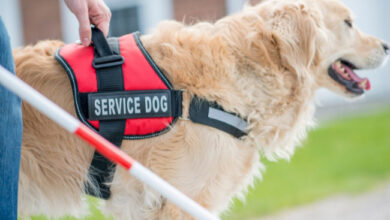
Emotional support animals – they’re recognized by law and should be recognized by you! ESAs have helped thousands of people suffering from very real and serious mental and emotional disabilities… yet people are still trying to take advantage of the ESA system. It’s giving people who have a real need for their ESA a bad name!
Understand the laws surrounding assistance animals to find out the truth.
What is an Emotional Support Animal?
An ESA is a friend, a companion, a shoulder to cry on and a provider of much-needed support for many Americans!
By law, an emotional support animal is an untrained animal (any animal) that provides emotional support to a person with mental or emotional disabilities.
Unlike trained service animals, for example, a guide dog for the blind, ESAs have no training or special skills. They offer comfort, affection, and support just by being there for you.
Although both ESAs and service animals are called ‘assistance animals’ knowing the difference between the two is important for understanding the laws surrounding them.
Can It Really Be ANY Animal?!
Yes!
An ESA can be any animal that offers you emotional support. From ferret to feline to fish, if they provide emotional support, they can be your ESA.
To prove your need for an ESA, you need a letter from a Licensed Mental Health Professional that confirms:
- That you’re a patient of that Licensed Mental Health Professional for a mental or emotional disability, e.g. PTSD.
- That your disability significantly limits you in day to day life, e.g. you don’t feel comfortable answering the door or going out by yourself.
- That they are prescribing an animal to help you as an ESA, e.g. an ESA dog so you don’t have to be alone and give you the support to cope with your disability.
Once you have an ESA, the federal laws ensure that you and your animal are treated fairly, especially when it comes to traveling and accommodation.
Feline Friends and Canine Companions Are Best
Although the federal laws are about ESAs in general, there are some complications if you choose an obscure ESA.
First, your psychiatrist or other licensed professional won’t be keen on prescribing an ESA that they don’t believe will help you.
You’ll also run into trouble with airline and accommodation laws – they’re both within their rights by law to decline you if your ESA is considered a danger (more on these laws below).
It’s best to stick with cats and dogs for ESAs! They’re friendly, easy to travel with and the laws are designed around domestic pets like these.
ESAs – Are They Fake? Discover the Truth
Some ESA owners create a bad rep when they try to take their exotic animal on an airline with no notice and end up making headlines… but ESAs are no joke, they are recognized by the law and should be taken seriously!
The laws in place are there to ensure people that genuinely need an ESA to get the support they need to live and travel comfortably.
But there are also laws in place to ensure people don’t take advantage. It varies from state to state, but you could face serious charges, fines and even sentences for pretending your pet is an ESA, selling fake ESA registrations or certificates, or trying to use a fake ESA letter to your advantage.
ESA Accommodation Laws
Living with your pet, especially in rented accommodation, can cost quite a bit of money. Some landlords may even deny you accommodation if you want to live with your pet.
That’s where the Fair Housing Act comes in.
The Fair Housing Act
The FHA is here to ensure that anyone with a disability isn’t discriminated against by landlords or housing providers. That includes those with ESAs.
It gives you the right to reasonable accommodation for you and your ESA, without any additional fees and deposits. Property owners can’t question you about your disability, request ID for your pet or refuse you accommodation – but they will need to see your ESA letter. You will need to provide your emotional support animal letter to the landlord so that they can verify that it is legit.
There are law exceptions that you should note too:
- If your specific pet has shown threatening or disruptive behavior, the property owner can legally deny you accommodation. They can’t, however, discriminate against your pet just because of the breed.
- Livestock and other animals not suited to living in a property (e.g. a cow) can be denied accommodation – another reason to be sensible when choosing an ESA!
- If your animal damages the property or the animal is being neglected, the property owner could reclaim fees later.
Traveling with An ESA – Know Your Rights!
You might have seen service animals, particularly dogs, guiding the blind and disabled through public transport, in taxis and dining in restaurants next to their owners.
But the laws for ESAs aren’t the same!
You can only take your ESA to places and locations where pets are allowed. That means buses, cafes and even beaches that don’t allow pets are not required by law to let you in.
But when it comes to planes, there’s a very specific federal law that ensures your right to travel.
The Air Carrier Access Act
The ACAA is in place to make sure you are not discriminated against because of your disability and need for an ESA.
Basically, many airlines will allow you to fly with your ESA without added fees! On some airlines, you can even have your pet on your lap for the flight.
To fly with your ESA under the ACAA, you need to:
- Prove to the airline your need for an ESA with your ESA letter and any other documentation the specific airline requires (veterinary health forms, behavior forms, etc.)
- Be flying to a destination that allows your species/breed of pet to enter
- Are flying to/from an airport that has the facilities to transport animals
You may also need to comply with other requirements set by the specific airline.
Some may need additional documents from your vet, while others must be contacted way in advance of the day you fly.
We always recommend that you contact the airline ASAP to find out what you need to do!
Snakes on a Plane?!
Not all ESAs are allowed on planes either. An airline is completely within their rights to deny you passage if they believe your pet is a danger, behaving disruptively, upsetting other passengers or just isn’t suited to flying!
Some airlines, in particular, have lists of brachycephalic cat and dog breeds that can’t fly without health risks.
Taking snakes, birds and other obscure ESAs on planes causes a lot of hassle and stress for you and the airline. Cats and dogs are best!
ESA Need to Know Recap
- Emotional support animals are recognized by law as assistance animals
- All ESA animals are recognized by law, but cats and dogs are the best!
- You need a letter from a licensed mental health professional to prove your need for an ESA
- You can face serious penalties for taking advantage of these laws and using fake ESA documents,
- The Fair Housing Act ensures you receive reasonable accommodation without discrimination or additional fees.
- The Air Carrier Access Act ensures you can travel with your pet on airplanes without discrimination or additional fees.
- You can always check back with CertaPet for up-to-date details on all the Emotional Support Animal laws!
Popular Posts:



